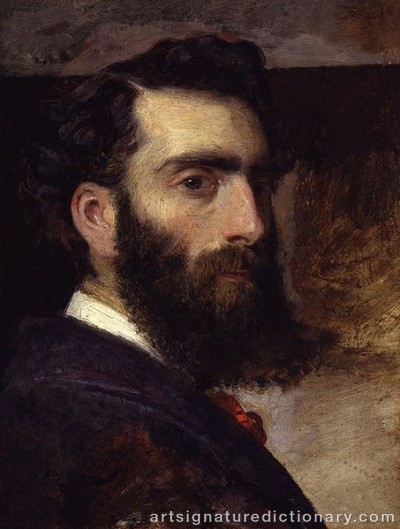
Philip Hermogenes CALDERON
1833–1898, France/England
Also known as: PHC
Philip Hermogenes Calderon was born in Poitiers in 1833, the son of Juan Calderon, a Roman Catholic priest who had left the church to marry. The family moved to England in the 1840s, when the father became the Professor of Spanish Literature at King’s College, London. The next we hear of Calderon junior, was that he was studying at Leigh’s Academy in 1850. At Leigh’s he started painting, mainly from life. He then went to study in Paris at the atelier of Monsieur Picot, a Membre de l’Institute, the equivalent of an Academician. Here he was not permitted to paint, being compelled to draw from the model, the result required being perfectly accurate from head to toe. This basis of sound draughtsmanship served him well throughout his distinguished career. On his return from France Calderon painted By the Waters of Babylon we sat down and Wept, which was a success at the Royal Academy Summer Exhibition of 1852. Strangely he did not follow this up quickly, and for the next five years painted mainly portraits. In 1857 he exhibited at the RA again, this time the picture was Broken Vows. This is one of the most celebrated Victorian pictures, which was engraved and reproduced by the thousand for over twenty years. An elegant, beautiful girl is listening behind a rustic fence, as her disloyal lover is making approaches to another young woman. The young woman was described as being in “an agony of despair.” Calderon was a skilled painter of attractive young women, and had the ability to show their emotions in a way which appealed to Victorian sentiment, and was regarded as chivalrous. He was also the leader of the St John’s Wood Clique, a group of artists who resident in the area, painted history pictures mainly based on the English Civil War, and who lead a vigorous social life. Other members included Frederick Yeames. Philip Calderon the man was a master of self-presentation, being tall, immaculately dressed, and looking - it was often said - like a figure who had stepped straight from a picture by Velasquez. He was a rather exotic, and popular individual, with a charm all of his own. He enjoyed parties, where his behaviour was often boisterous.
Calderon continued to exhibit at the RA, and in 1861 showed Demande en Mariage, and Releasing Prisoners on the Young Heir’s Birthday, the second being an example of the historical genre pictures which were another speciality of his. In 1864 Calderon became ARA. In 1867 he won a gold medal at the Paris International Exhibition - rather unsurprising to London critics who regarded his work as an intelligent fusion of English emotion and French panache. In this year he became a full Academician, at the young age of thirty-four. From 1870 onwards he was primarily a painter of portraits. Calderon’s picture Saint Elizabeth of Hungary’s Great Act of Renunciation, by showing the saint kneeling naked in front of the altar in a chapel. The incident is one of historical fact, but the offence was caused by a woman being shown nude in the presence of men. From 1887 he became Keeper of the Royal Academy with responsibility for the management of the RA schools, and in this role lived within Burlington House. The responsibilities of the post reduced his output of pictures. Calderon died suddenly in 1898.
Source: http://www.artrenewal.org/pages/artist.php?artistid=550